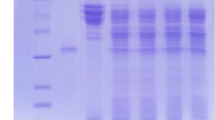Abstract
Although recent evidence clearly indicates that trypsin inhibitors (TI) and low protein digestibility are the major factors responsible for the pancreatic hypertrophic and growth inhibitory effects of raw soybeans, there was uncertainty regarding the biological threshold level of TI at which these biological effects occur. To obtain such data, dehulled defatted flakes (10% dietary protein) containing graded levels of TI were fed to weanling rats for 4 weeks in two feeding trials. Normal pancreas weights were obtained in rats fed samples in which only 54 to 68% of the original TI of raw soya flour was inactivated. In partially toasted flakes with a nitrogen digestibility value of 77%, the average tolerance level of dietary TI activity that did not cause pancreatic hypertrophy was calculated to be 385 mg TI/100 g diet. TI tolerance level at maximum nitrogen digestibility of 85%, which did not significantly lower weight gain and reduce protein efficiencey ratios, was 260 mg TI/100 g diet. Continuous ingestion of high levels of TI (459 mg TI/100 g diet) in a 20% protein diet for 215 days did not inhibit growth nor cause pancreatic hypertrophy when compared to rats fed toasted soya flour diets. Pancreatic hypertrophy that occurs in rats fed raw soya diets containing up to about 1300 mg TI/100 g diet for 35 days was reversed by switching the rats to control diets or to 30% toasted flour. In long-term feeding studies, no pancreatic hypertrophy occurred in rats fed commercial edible-grade soya flour, concentrate, or isolate from time of weaning to adulthood (ca. 300 to 330 days). TI content of the diets ranged from 178 to 310 mg/100 g diet. Microscopic examination of the pancreas revealed no abnormalities. Gross appearances of heart, kidney, spleen and liver were normal. In long-term feeding, vitamin B-12 supplements were needed to provide optimum growth and to maintain body weight. Results of numerous chemical analyses, relatively short-term human tests and long-term animal feeding studies indicate that with proper control of manufacturing processes, soya protein products can be produced that, in mixed diets, have protein nutritional value approaching that of animal protein.
Similar content being viewed by others
References
Liener, I.E. and M.L. Kakade, in “Toxic Constituents of Plant Foodstuffs,” 2nd edition, edited by I.E. Liener, Academic Press, Inc., New York, NY, p. 7.
Rackis, J.J., J.E. McGhee and A.N. Booth, Cereal Chem. 52:85 (1975).
Rackis, J.J., J.E. McGhee, M.R. Gumbmann and A.N. Booth, JAOCS 56:162 (1979).
Sessa, D.J., D.H. Honig and J.J. Rackis, Cereal Chem. 46:675 (1969).
“Soybeans: Chemistry and Technology,” edited by A.K. Smith and S.J. Circle, Vol. I, Proteins, Avi Publishing Co., Westport, CT, 1972.
American Oil Chemists’ Society, Official and Tentative Methods.
Kakade, M.L., J.J. Rackis J.E. McGhee and G.A. Puski, Cereal Chem. 51:376 (1974).
Rackis, J.J., J.E. McGhee, I.E. Liener, M.L. Kakade and G. Puski, Cereal Sci. Today 19:513 (1974).
Hamerstrand, G.E., L.T. Black and J.D. Glover, Cereal Chem., in press.
Smith, C., W. Van Megan, L. Twaalfhoven and C. Hitchcock, J. Sci. Food Agric. 31:341 (1980).
Kakade, M.L., N.R. Simons and I.E. Liener, Cereal Chem. 46:518 (1969).
Duncan, D.B., Biometrics 11:1 (1955).
Rackis, J.J., Fed. Proc. 24:1488 (1965).
Booth, A.N., et al., Proc. Soc. Exp. Biol. Med. 116:167 (1964).
Rackis, J.J., in “Antinutrients and Natural Toxicants in Foods,” edited by R.L. Ory, Food and Nutrition Press, Inc., Westport, CT, in press.
Liener, I.E., in “Biochemical Aspects of New Protein Food,” edited by J. Adler-Nissen, Pergamon Press, New York, NY, 1977, p. 129.
Goss, R.J., Science 153:1615 (1966).
American Oil Chemists Society, Proceedings of World Conference on Vegetable Food Proteins, Amsterdam, Netherlands, 1978, JAOCS 56:99 (1979).
“Soy Protein and Human Nutrition,” edited by H.L. Wilcke, D.T. Hopkins, and D.H. Waggle, Academic Press, New York, NY (1979).
Van Stratum, P.G., Cereal Foods World 23(5):234 (1978).
Author information
Authors and Affiliations
About this article
Cite this article
Rackis, J.J. Significance of soya trypsin inhibitors in nutrition. J Am Oil Chem Soc 58, 495–501 (1981). https://doi.org/10.1007/BF02582412
Issue Date:
DOI: https://doi.org/10.1007/BF02582412




